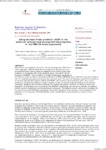Por favor, use este identificador para citar o enlazar este ítem:
http://www.alice.cnptia.embrapa.br/alice/handle/doc/480865| Título: | Using the best linear predictor (BLP) in the selection between and among half-sib progenies of the CMS-39 maize population. |
| Autor: | PACHECO, C. A. P.  RIBEIRO JUNIOR, J. I.   CRUZ, C. D.   |
| Afiliación: | EMBRAPA/CNPMS. |
| Año: | 1997 |
| Referencia: | Brazilian Journal of Genetics, Ribeirão Preto, v. 20, n. 4, p. 683-690, 1997. |
| Descripción: | Data of corn ear production (kg/ha) of 196 half-sib progenies (HSP) of the maize population CMS-39 obtained from experiments carried out in four environments were used to adapt and assess the BLP method (best linear predictor) in comparison with to the selection among and within half-sib progenies (SAWHSP). The 196 HSP of the CMS-39 population developed by the National Center for Maize and Sorghum Research (CNPMS-EMBRAPA) were related through their pedigree with the recombined progenies of the previous selection cycle. The two methodologies used for the selection of the twenty best half-sib progenies. BLP and SAWHSP, led to similar expected genetic grains. There was a tendency in the BLP methodology to select a greater number of related progenies because of the previous generation (pedigree) than the other method. This implies that greater care with the effictive size of the population must be taken with this method. The SAWHSP methodology was efficient in isolating tha aditive genetic variance component from the phenotypic component. The pedigree system, although unnecessary for the routine use of the SAWHSP methodology, allowed the prediction of an increase in the inbreeding of the population in the long term SAWHSP selection when recombination is simultaneous to creation of new progenies. |
| Thesagro: | Milho Melhoramento Seleção Zea Mays |
| NAL Thesaurus: | breeding |
| Palabras clave: | Maize Selection |
| Tipo de Material: | Artigo de periódico |
| Acceso: | openAccess |
| Aparece en las colecciones: | Artigo em periódico indexado (CNPMS)  |
Ficheros en este ítem:
| Fichero | Descripción | Tamaño | Formato | |
|---|---|---|---|---|
| Usingbest.pdf | 180,54 kB | Adobe PDF |  Visualizar/Abrir |









